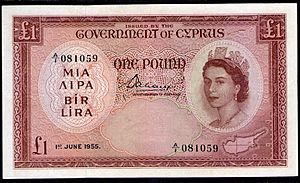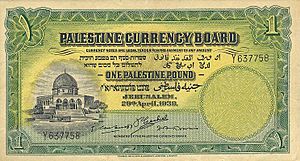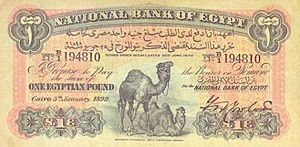British currency in the Middle East facts for kids
The British started getting involved in the Middle East a long time ago, beginning with a special agreement called the General Maritime Treaty of 1820. This treaty helped create the Trucial States (which are now part of the United Arab Emirates) and the island of Bahrain. The main goal was to stop pirates in the Persian Gulf and keep trade routes safe.
In 1839, the British East India Company set up a base in Aden (now part of Yemen). This was also to fight pirates and protect British ships traveling to and from India. Later, in 1875, Britain became very interested in Egypt because of the important Suez Canal, which was a shortcut for ships. This led to a full British invasion of Egypt in 1882.
More areas joined the British sphere of influence. Muscat and Oman became a British Protectorate in 1891. Kuwait joined the British Empire in 1899 because Britain was worried about Germany's growing power and a planned railway called the Berlin-Baghdad Railway. Britain feared this railway would give Germany too much access to the Persian Gulf. Finally, Qatar became a British Protectorate in 1916. After the First World War, British influence in the Middle East grew even more, including areas like Palestine, Transjordan, and Iraq.
Contents
Why did British money spread?
For almost 400 years, silver Spanish dollars, also known as "pieces of eight," were the main money used around the world. Most of these coins were made in places like Mexico City and Lima in the Americas.
In 1821, the United Kingdom started using a gold standard for its money, meaning their pound was based on gold. They then wanted to introduce the British pound currency into all their colonies. This started in 1825, especially as the supply of Spanish dollars was running low after revolutions in Latin America.
However, this new rule didn't apply to India at first. India was controlled by the British East India Company until 1857. So, the silver rupee continued to be the money in India. The Indian rupee was not just used in India, but also in many places to its west, including parts of Africa, Aden, Muscat, and along the Arabian coast of the Persian Gulf.
Later, when the Middle East became part of the British Empire, the British government had learned a lesson. They realized it was hard to force a new currency on people who already had their own money. So, even though the idea of the "pound" spread to the Middle East, the smaller coins like shillings and pence were not used there. Instead, local money systems were often linked to the British pound.
Cyprus and its money
The first place in the Middle East to use the pound sterling as a unit of account was Cyprus. When Britain took control of Cyprus in 1878, they decided that a Turkish lira was worth about nine-tenths of a British pound.
There were some problems, though. Even though one Turkish lira was supposed to be 100 Turkish piastres, this wasn't always true in different places. Also, copper piastres were worth less than silver piastres. People even exported gold coins from Cyprus to other places to make more money.
To fix this, the British government stopped using the old Turkish piastres. In 1879, they introduced a new bronze British piastre. They set its value so that 180 of these piastres were equal to one British gold sovereign. This made it less profitable to send gold out of Cyprus. The new 9-piastre and 18-piastre coins were similar in size and value to the shilling and florin coins in the UK, but they weren't called shillings or pence.
The Cyprus Currency Board was set up in 1927 to manage the Cypriot pound. In 1947, the word "shilling" finally appeared on the 9-piastre and 18-piastre coins. Then, in 1955, Cyprus changed its money system to a decimal one, where 1,000 Mils made one pound.
Cyprus became independent in 1960. When the UK allowed its pound sterling to "float" (meaning its value could change freely) in 1972, the Cypriot pound started to have a different value than the British pound. Before this, they had always been worth the same. In 2008, Cyprus started using the euro, and the Cypriot pound stopped existing.
Palestine and its money
After Britain took control of Mandatory Palestine in 1918, the Egyptian pound was used there, along with the Ottoman lira. This caused confusion. So, in 1927, the British authorities created the Currency Board for Palestine. This board introduced the Palestine pound.
The Palestine pound was worth the same as the pound sterling. It was official money in Mandatory Palestine and in Transjordan. However, it didn't use British shillings and pence. Instead, it used a decimal system where one pound was divided into 1,000 mils.
The Currency Board closed in May 1948 when the British Mandate ended. But the Palestine pound was still used for a short time:
- Israel started using the Israeli pound in August 1948, which was equal to the Palestine pound. It stayed equal to the British pound until 1952.
- Jordan started using the Jordanian dinar in 1949. The dinar then became a popular name for the pound sterling unit in the Middle East. The Jordanian dinar stayed equal to the British pound until 1967, when the British pound lost some of its value. The Jordanian dinar did not change its value, so it was no longer equal to the British pound.
- In the West Bank, the Palestine pound was used until 1950. Then, the West Bank became part of Jordan, and the Jordanian dinar became the official money.
- In the Gaza Strip, the Palestine pound was used until 1951. It was then replaced by the Egyptian pound after the Egyptian army took control.
Money in Arabia and Mesopotamia
Before Britain got involved in Arabia, people used Ottoman piastres and Maria Theresa thalers. The thaler was usually worth 20 piastres. The word "dollar" actually comes from "thaler."

When the British arrived in Aden in 1839, they brought Indian rupees. British influence spread to the Gulf States, and so did the Indian rupee. During the First World War, the Indian rupee also spread into Mesopotamia (modern-day Iraq).
In 1928, the Kingdom of Hejaz and Nejd (which became Saudi Arabia) introduced a new silver riyal. Its value was set to be exactly one-tenth of a British gold sovereign. In 1936, the riyal's value was changed to match the Indian rupee.
Meanwhile, in 1931, Iraq, which was under British control, started using the Iraqi dinar. It replaced the Indian rupee and was worth the same as the pound sterling. This continued until 1967, when the British pound lost value, and the Iraqi dinar did not.
In 1951, the East African shilling replaced the Indian rupee in Aden. Twenty shillings were equal to one pound sterling. The East African shilling had been created in 1922 from the Indian rupee.
In 1959, to stop gold smuggling, the Indian government and British authorities replaced the Indian rupee in the Gulf States with the Gulf rupee. It was worth the same as the Indian rupee.
Changes in the 1960s and beyond
In 1961, Kuwait started using the Kuwaiti dinar. It replaced the Gulf rupee and was worth the same as the pound sterling. Like other currencies, it stopped being equal to the British pound in 1967 when the British pound lost value.
In 1965, the South Arabian dinar replaced the shilling in Aden. It was worth 20 shillings to the dinar. This currency did change its value along with the British pound in 1967. The South Arabian dinar was later renamed the South Yemeni dinar. It eventually stopped existing when South Yemen joined North Yemen in 1990.
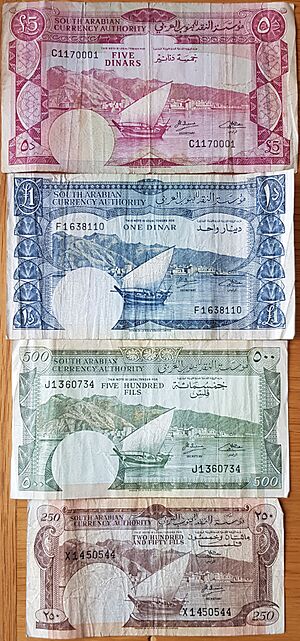
In 1965, Bahrain replaced the Gulf rupee with the Bahraini dinar. Its value was set at fifteen shillings sterling. This value increased in 1967 when Bahrain did not change its currency's value along with the British pound.
In 1966, India changed the value of its rupee. This led Qatar, Dubai, and most of the Trucial States (except Abu Dhabi) to introduce a new riyal. It was worth the same as the rupee before its value changed. Abu Dhabi chose to use the Bahraini dinar instead. In 1973, it switched to the United Arab Emirates dirham along with the other areas in the UAE.
In 1970, the Sultanate of Oman replaced the Gulf rupee with the Omani rial. It was created to be worth the same as the pound sterling. Two years later, when the British pound's value started to float, the Omani rial also began to have a different value.
Quick summary of money changes
Many currencies in the Middle East, like those in Israel, Jordan, Iraq, Kuwait, Oman, and Yemen, originally came from the idea of the pound sterling. The Bahraini dinar is partly related. The money used in Qatar and Dubai from 1966 replaced the Indian rupee.
Today, there's no clear link between these currencies and the money used in the United Kingdom.
Egypt and its money
In the early 1800s, Egypt and Turkey used the same money, the Ottoman piastre. But in 1834, Egypt started making its own coins. They decided to base their money on both silver and gold, using the Maria Theresa thaler as a guide. This thaler was a popular silver coin in the region.
Egypt then made a gold coin called the bedidlik, worth 100 piastres, and a silver rial coin worth 20 piastres (like the Maria Theresa Thaler). In 1839, a British gold sovereign was worth 97.5 piastres in Egypt. Even though 100 Egyptian piastres were called a "pound" in English, it wasn't the main unit of money until 1885.
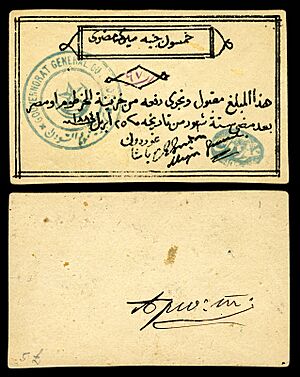
In 1885, Egypt officially switched to a pure gold standard. The Egyptian pound unit, called the juneih, was introduced. It was based on the amount of gold in the British gold sovereign, keeping the value of 97.5 piastres to the pound sterling. This new pound replaced the Egyptian piastre as the main currency. Banknotes with the word "pounds" in English didn't appear until 1899.
The piastre continued to be used as one-hundredth of a pound. Smaller units called paras were stopped in 1909, and the piastre was divided into tenths. These tenths were renamed milliemes in 1916.
When World War I started, the British pound's value was no longer fixed to gold. The Egyptian pound was then linked to the British pound, with one Egyptian pound being worth about one pound and sixpence sterling. This meant about £E0.975 for one pound sterling. This exchange rate continued until the early 1960s, when Egypt slightly changed its currency's value and linked it to the United States dollar.
Where else was the Egyptian pound used?
The Egyptian pound was also used in the Anglo-Egyptian Sudan. From 1918 to 1927, it was official money in Mandatory Palestine. Later, between 1942 and 1951, when Cyrenaica (part of Libya) was under British control, the Egyptian pound was used there too.
Libya and its money
When Libya was part of the Ottoman Empire, it used the Ottoman piastre. In 1911, when Italy took over, the Italian lira was introduced. In 1943, after Italy was defeated in World War Two, Libya was split into French and British controlled areas. French money was used in the French area. In the British area, the military authorities issued the Tripolitanian lira, which was used alongside the Egyptian pound.
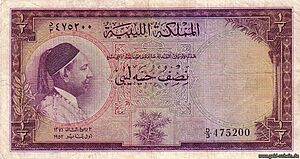
In 1951, the Libyan pound was introduced. It replaced the French and Italian money and was worth the same as one pound sterling. When the British pound lost value in 1967, the Libyan pound did not. So, one Libyan pound became worth more than one British pound. The Libyan pound was replaced by the dinar in 1971, after the Libyan Revolution.
Sudan and its money
The Egyptian pound was also used in the Anglo-Egyptian Sudan. However, when Sudan became independent in 1956, the Egyptian pound was replaced by the Sudanese pound in 1957. During the 1960s, the Sudanese pound's value became different from the Egyptian pound. From 1969 to 1971, the Sudanese pound was linked to the pound sterling.
The Sterling Area
At the start of Second World War, the "sterling area" was created. This was an emergency plan to protect the value of the pound sterling, especially against the US dollar. All the places mentioned above joined this area because their own money (pounds, dinars, shillings, or rupees) was linked to the pound sterling. For example, the Indian rupee was linked to the pound sterling at a fixed value.
After the war, some countries left the sterling area, including Egypt and Sudan (1947), Israel (1948), and Iraq (1959). Libya was removed in 1971.
Because the British pound's value changed in 1967 and again in 1972, and because the system of fixed exchange rates ended, none of the currencies mentioned above are still linked to the British pound today. There is no longer a clear connection between these currencies and the money of the United Kingdom.
See also
- British currency in Oceania
- British currency in the South Atlantic and the Antarctic
- British currency in West Africa
- East African shilling
- Old Israeli shekel
- Palestine pound
- South Yemeni dinar


